CA Wine Country: Napa, Sonoma, Mendocino, and Russian River
(Note: Full reviews of all the restaurants we visited are on our food review site, http://exegesis.yolasite.com/)
In early May 2010 we began our retirement by traveling through the Wine Country. As we live close by, we often visit for day trips but until our retirement, hadn't stayed overnight in the area. The starting point was a Road Scholar CA Delta cruise, posted previously.
After it ended, we kept on driving northwest . We now visit Napa and Sonoma separately, 3-4 times a year, making midweek trips of 3-4 days at a time. Spring is the best season up here. Although still very cool and windy, layers of Polarfleece along with sunblock and a hat/cap are all that's needed. This time of year there are relatively few tourists, which is good because these roads are mostly two-laners. Traffic can be hideous at summer's height. We avoid summer months, although that means we're risking rain and wind instead of crowds and cars!
In the Wine Country, the major cities have the same name as the county does, confusing many visitors. Summers are hot, although nights always cool off considerably. In ‘low season’, hotel prices are much less costly. Memorial Day through October is ‘high season’, with early October being the popular “crush” of grape harvest.
Hotels and restaurants are as costly as San Francisco is, which means you pay a lot of $$$. But there are some lower-cost, older hotels, not top-quality but adequate. Eating - well, if you don't drink (we don't), you can get away with $30-150/person for a meal. But if you drink it'll cost more, although the selection is usually excellent. A few restaurants will charge for corkage, so always check first.
NAPA
We highly recommend the (Napa Valley) tour at Castello di Amoroso, the medieval reconstructionist castle built by the head of Sattui Winery (URL: http://www.castellodiamorosa.com/). It's a medievalist's dream, with magnificent stonework and superb brick vaulting of the kind almost no one in the world knows how to do any longer. The gardens are simple but pretty with vineyards around, with a small flock of the fattest, happiest-looking chickens I’ve seen in a long time.
The food is wonderful in Napa County, which includes Yountville, Rutherford and Calistoga. We loved Bottega , Oenotri and La Toque, and adored Auberge du Soleil, but there are many other (expensive) places equally good.
Right: Beyond a hedge, vineyards and mountains

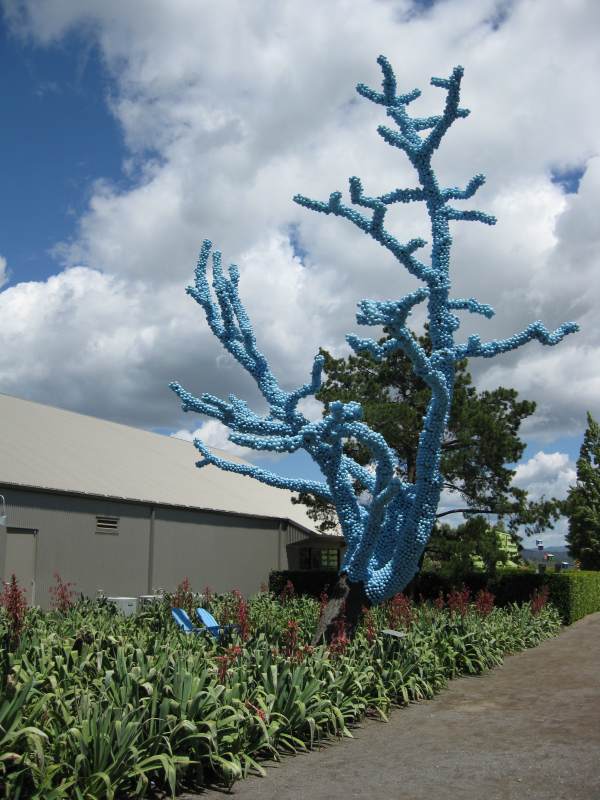
General Vallejo's home, Lachryma Montis, is a nice way to spend an hour or so. It's accessible either by car or along the bike path we discovered (which actually starts at Sebastiani Winery, and travels past the Depot Museum and various tennis, soccer, and baseball fields).
Lachryma Montis is a classic Victorian farmhouse. It has the unmistakable feel of a working rural home, as opposed to the urban Victorian mansions we're accustomed to in San Francisco.
So far our preferred hotel in Sonoma is the Sheraton Sonoma Cty in Petaluma. We have friends who live in that city, and it's a good central spot for going in any direction to reach Sonoma County's many attractions. Hwy 101, however, is a bottleneck at commute times, so you have be careful to time your distances between activities.
We actually prefer to eat outside the city of Sonoma. We love French food, and have gotten amazing meals at Bistro 29/Santa Rosa and French Garden/Sebastopol. We also adore Yanni's Sausage Grill, a tiny storefront with blazing hot Greek chili (their own invention) and housemade sausages on grilled pressed local-made bread.
SONOMA
Sonoma (the city) is everybody’s favorite. It has the most charming town square in the Wine Country, with several historical buildings worth a quick look. Dining is not quite as good as in Napa, although Café La Haye and Girl and The Fig are perennial favorites with everyone . Depot Hotel is less crowded and also delightful. Sonoma has a wonderful paved bike trail a few blocks north of the square that is a 4.7 mile walk and very pleasant (bring your own water bottle!).We stopped in at Cornerstone Gardens, outside Sonoma (URL: http://www.cornerstonegardens.com/gardens.php). Several acres of landscaped gardens, these are professional displays. Some are sculptural, some quirky, some modernist, some whimsical. Very interesting, and they change periodically.
Left: Blue Bottle Tree, Cornerstone Gardens Sonoma, by Claude Cormier, Claude Cormier Architects, Montreal Canada
Below: Artichokes, Cornerstone Gardens Sonoma
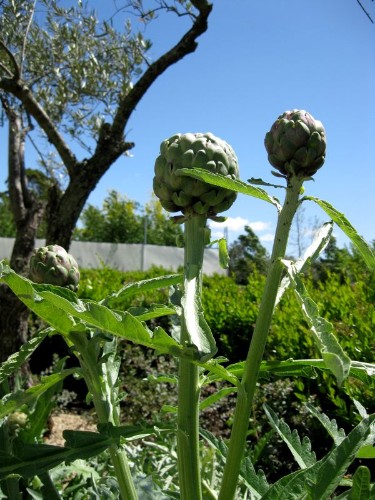
There are many wonderful back roads in Marin and Sonoma to drive. Some of our favorites are:
-
Hwy 128, which runs east/west from Geyserville/Sonoma Cty to Calistoga/Napa Cty. Outside of the River Rock Casino weekend traffic, you'll hardly see any traffic along this road. It's the best "back door" entrance to Napa and Sonoma.
-
Marshall-Petaluma Road, a scenic route through the hills that goes through the historic Two Rock Valley
- Bohemian Highway, which runs parallel to Hwy 101 and is a beautiful way to access the towns of Occidental and Graton
.
Going to Mendocino from Sonoma is a long, tiring drive. We've stopped at Ledson Castle, the recent-vintage brick Gothic Victorian built by the Ledson family, which owns a lot of businesses in the area. It's architecturally interesting, but the second floor is closed to the public; reserved for club members only. The woodwork at Ledson is impressive, as is the concrete brickwork and custom doublepaned windows. I prefer the Castello in Yountville, but Carlos liked the light-filled interior of Ledson Castle. He admired the two-sided fireplaces in several of the tasting rooms. This is a nice stop when in the area - it's located north of the town of Sonoma .

Above: Sculptural agave plants in a meadow of grass and poppies, in a landscape display at Cornerstone Gardens, Sooma
MENDOCINO
Hwy 128 goes through Boonville and Philo. It's a long drive, so we don't have time to stop. In spring everything is damp and green, so the drive is a bit tiring but delightful. Huge tree stumps from pre-1920’s logging are ghostly, moss-heavy reminders of today’s big 18-wheeler logging trucks that still travel the highways. Mendocino is a very small town with no commercial development. We like to stay at Agate Cove Inn, a B&B which is one mile north of the town of Mendocino.
Right: Gauze-drapped 4-poster in Zircon cottage, Agate Cove Inn, Mendocino The food in Mendocino is terrific. Cafe Beaujolais wows us, as does Rendezvous in Ft. Bragg. Breakfast at MacCallum House is idyllic: homemade breads and jams, friendly service, a sunny porch dining area. Sadly, the recession has hit the area hard, and Rendezvous is now for sale (it's a combination inn/restaurant) .
Mendocino is such a small town it takes very little time to walk through it. Some of the stores are charming, and one art gallery has a terrific folk art piece, a wooden Noah's Ark that is wonderful. The two little skunks are being towed in their own little boat behind the ark, a humorous touch that makes Carlos and I laugh.
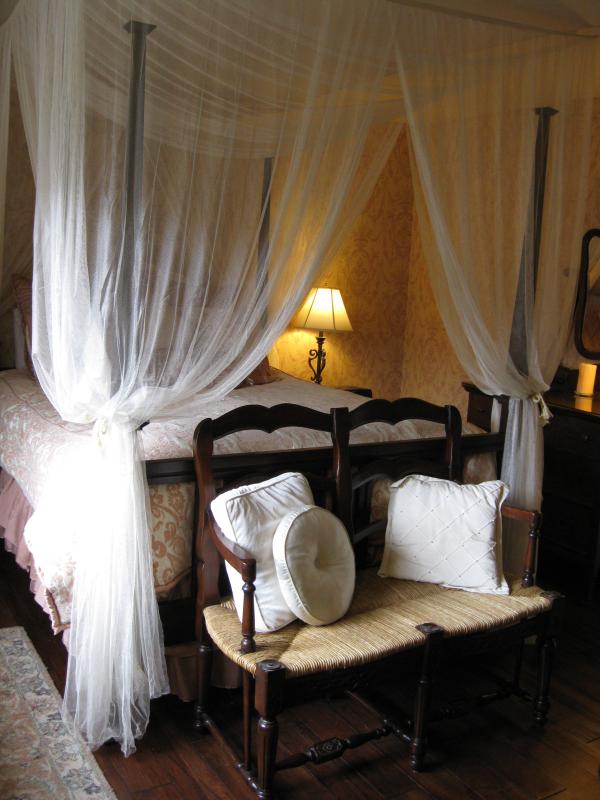
Speaking of skunks, we can heartily recommend taking the Skunk train, which follows close to the Noyo River out to Willits. There are some great photo opportunities here, and we learn a lot. The conductor was an old California Western employee who gave a great talk on the history of the two lumber companies and the various small camps we passed, some of which are still in use by groups such as the Boy Scouts and Boys and Girls Club.
We learned why there are huge old stumps everywhere - the old logging technique prior to the 1920's used a piece of wood called a springboard, inserted into the tree about 10-12' from the ground. The logger stood on that board and then cut the tree down. They used oxen to haul the logs out. In the 1920's they began to use the current clear-cutting technique. Now the river redwoods are permanently protected from logging.

It's amazing to see where heavy brush and young redwoods almost completely obscure the river for miles, yet hear that in 1940 some of these sections were cleared out as far as the eye could see. Redwoods can grow very fast, and suck up huge amounts of water (up to 300 gallons per day!). As we ride along, the guide points out some older redwoods, including a 10-acre stand has never been cut at all.
Right beside the tracks is a tree that's 1000 yrs old, dated by Humbolt State University researchers who were analyzing weather patterns by using a core sample from this tree. It was never logged because long ago it was struck by lightning. We learned that loggers avoid such trees because it causes molecular changes to the wood itself. Such a tree can't be used, when a saw tries to cut it the wood shatters apart.
Left: Noyo River, beside Skunk train tracks
Mendocino's Botanical Gardens is one of the great North Coast gardens. Spring is best with the early rhodies but the late rhodies are still blooming in May. The vast majority of the 47 acres is coastal wilderness trails, winding up and down alongside the cliffs. The views are spectacular. The paths all wind and twist, even in the landscaped front gardens, so like Golden Gate Park in San Francisco, you are walking much further than you think in order to cover everything. Although Carlos doesn't garden, he loved this public garden, so we visit every time we come to hike the winding trails. No matter what time of year, it's always beautiful.
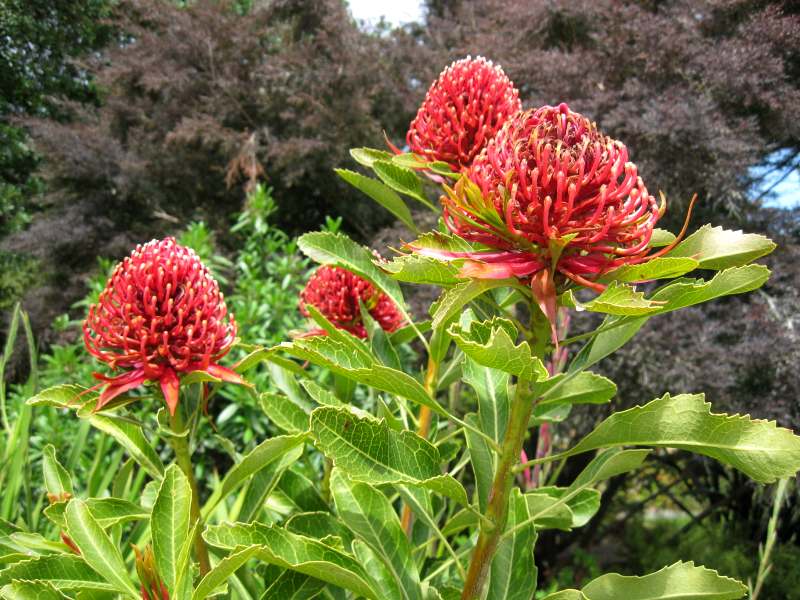
Above: Telopea, Mendocino Botanical Gardens
Right: Variegated Rhododendron, Mendocino Botanical Gardens
Below: Woodland garden, Mendocino Botanical Gardens
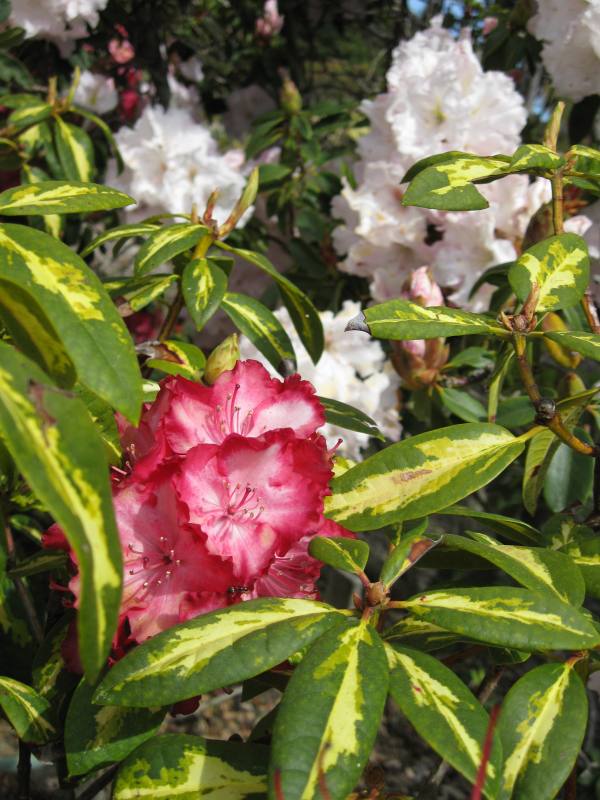

From Mendocino we have found it faster to take Hwy 20 to return south via Hwy 101. Living in the Bay Area gives one the opportunity to enjoy the best of what the Bay Area has to offer. It's no wonder people come here from all over the world to visit.